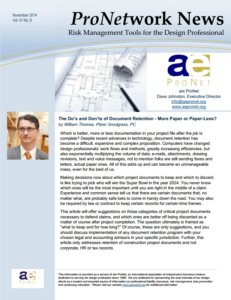 Which is better, more or less documentation in your project file after the job is complete? Despite recent advances in technology, document retention has become a difficult, expensive and complex proposition. Computers have changed design professionals’ work flows and methods, greatly increasing efficiencies, but also exponentially multiplying the volume of data; e-mails, attachments, drawing revisions, text and voice messages, not to mention folks are still sending faxes and letters, actual paper ones. All of this adds up and can become an unmanageable mess, even for the best of us.
Which is better, more or less documentation in your project file after the job is complete? Despite recent advances in technology, document retention has become a difficult, expensive and complex proposition. Computers have changed design professionals’ work flows and methods, greatly increasing efficiencies, but also exponentially multiplying the volume of data; e-mails, attachments, drawing revisions, text and voice messages, not to mention folks are still sending faxes and letters, actual paper ones. All of this adds up and can become an unmanageable mess, even for the best of us.
Making decisions now about which project documents to keep and which to discard is like trying to pick who will win the Super Bowl in the year 2024. You never know which ones will be the most important until you are right in the middle of a claim. Experience and common sense tell us that there are certain documents that, no matter what, are probably safe bets to come in handy down the road. You may also be required by law or contract to keep certain records for certain time frames.
This article will offer suggestions on those categories of critical project documents necessary to defend claims, and which ones are better off being discarded as a matter of course after project completion. The question ultimately is framed as “what to keep and for how long?” Of course, these are only suggestions, and you should discuss implementation of any document retention program with your chosen legal and accounting advisors in your specific jurisdiction. Further, this article only addresses retention of construction project documents and not corporate, HR or tax records.
“Age of Discovery”
Modern construction projects, with all this data, are subject to modern lawsuits. These lawsuits are conducted by increasingly younger, tech savvy and sophisticated lawyers who sometimes make the litigation more about the discovery effort than about the facts of the case. Parties are allowed to submit detailed and specific “requests for production of documents” once in the lawsuit, or issue subpoenas to non-parties. State and federal court discovery rules could require parties to turn over copies of all information they have in their possession related to the project.
These “spare no expense” tactics drive up the cost of litigation and unfortunately are one of the many harsh realities of the process. Discovery requests can get at your paper files, as well as all of your “Electronically Stored Information” (ESI), such as e-mail and document servers, databases and other electronic documents. Everything is fair game, with few boundaries, so your files need to be in order.
Design professionals are a detailed bunch. Often, personnel on a project keep personal journals, phone logs, or other files where they maintain their own copy of project information. These “personal files” are discoverable project records the firm would have an obligation to produce once the litigation begins, so they too should be subject to collection and enforcement per the firm’s document retention program.
Document “Retention”
Nothing is more uncomfortable than hearing your client testify in a deposition about their firm’s “document destruction policy.” Document retention is the name of the game, even if it means at some point stuff is no longer retained. The point is that everyone should have a formal, written policy. Put it in the firm’s manual and disseminate it to employees. Inform your clients in your initial retention letter about the firm’s policy, and ask that they acknowledge and approve of it, so later there can be no question you did what you said you were going to do with those documents at the end of the job. The American Institute of Architects, (AIA) and National Society of Professional Engineers, (NSPE) both offer suggested policies on their websites as a starting point.
Once you have a written policy, the next step is to make sure it is enforced uniformly, across the board, every time the same way. No one can complain about your firm’s policy if it is uniformly enforced. You get into trouble when, on some projects more material was either kept or discarded than the policy provides. Assign an employee to manage the program and perform occasional audits to make sure it is being properly enforced. Periodically review the policy to keep it up to date with changing technologies and trends.
It would help to maintain the archived version of the file in a uniform and organized fashion, as opposed to simply dumping all the paper in a box, as it will save a lot of time on the back end. You will also need a place where all these records will be stored. Make sure your solution for electronic documents is secure and backed up. When discarding material, make sure it is disposed of securely, using shredding or other irreversible methods. The last thing you need when trying to dispose of a client’s file is a claimed “data breach” or violation of a confidentiality provision in your agreement.
To continue reading this newsletter, including specifically Things to Keep and Things Not to Keep, download the full PDF version of The Do’s and Don’ts of Document Retention – More Paper or Paper-Less? from our website.
About the Author:
William S. Thomas is a principal at Pitzer Snodgrass, P.C., in St. Louis, Missouri where he focuses his practice on handling matters involving the construction process, from up-front contract reviews, commercial litigation, professional liability defense and trial work. He has represented owners, contractors, subcontractors, architects, engineers, land surveyors and landscape architects in all phases of construction claims. He also handles product liability claims, other general commercial disputes and general liability claims. He is licensed to practice law in Missouri and Illinois, and several Federal Courts. He is involved in many professional organizations, and is a past president of the Lawyers Association of St. Louis, the local trial bar, and is active in the Missouri Organization of Defense Lawyers, the Defense Research Institute and its Construction Law Committee, Product Liability Committee, and Building Products – Substantive Litigation Group, and Professional Liability Committee, where he served on the Steering Committee, and Design Professional Subcommittee. Bill is an associate member of the ASCE and the AIA. He is a frequent lecturer and writer on a number of issues, from product liability to construction law.



